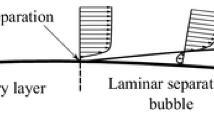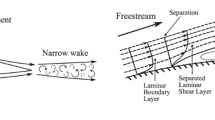Abstract
Time-resolved surface pressure measurements are used to experimentally investigate characteristics of separation and transition over a NACA 0018 airfoil for the relatively wide range of chord Reynolds numbers from 50,000 to 250,000 and angles of attack from 0° to 21°. The results provide a comprehensive data set of characteristic parameters for separated shear layer development and reveal important dependencies of these quantities on flow conditions. Mean surface pressure measurements are used to explore the variation in separation bubble position, edge velocity in the separated shear layer, and lift coefficients with angle of attack and Reynolds number. Consistent with previous studies, the separation bubble is found to move upstream and decrease in length as the Reynolds number and angle of attack increase. Above a certain angle of attack, the proximity of the separation bubble to the location of the suction peak results in a reduced lift slope compared to that observed at lower angles. Simultaneous measurements of the time-varying component of surface pressure at various spatial locations on the model are used to estimate the frequency of shear layer instability, maximum root-mean-square (RMS) surface pressure, spatial amplification rates of RMS surface pressure, and convection speeds of the pressure fluctuations in the separation bubble. A power-law correlation between the shear layer instability frequency and Reynolds number is shown to provide an order of magnitude estimate of the central frequency of disturbance amplification for various airfoil geometries at low Reynolds numbers. Maximum RMS surface pressures are found to agree with values measured in separation bubbles over geometries other than airfoils, when normalized by the dynamic pressure based on edge velocity. Spatial amplification rates in the separation bubble increase with both Reynolds number and angle of attack, causing the accompanying decrease in separation bubble length. Values of the convection speed of pressure fluctuations in the separated shear layer are measured to be between 35 and 50% of the edge velocity, consistent with predictions of linear stability theory for separated shear layers.


















Similar content being viewed by others
Abbreviations
- C L :
-
Sectional lift coefficient
- C p :
-
Mean surface pressure coefficient
- c :
-
Model chord length
- d :
-
Model height projected onto a streamwise-normal plane
- E pp :
-
Normalized energy spectrum of surface pressure fluctuations
- f :
-
Frequency
- f 0 :
-
Central frequency of disturbance amplification
- L :
-
Separation bubble length
- n :
-
Exponent in experimental correlations
- \(\tilde{p}\) :
-
RMS surface pressure
- \(\tilde{p}_{\rm max}\) :
-
Maximum RMS surface pressure at a particular α
- q e :
-
Dynamic pressure based on edge velocity, \(q_{e} = \frac{1}{2}\rho U_{e}^2\)
- q ∞ :
-
Free-stream dynamic pressure, \(q_{\infty} = \frac{1}{2}\rho U_{\infty}^2\)
- Re :
-
Chord Reynolds number, Re = U ∞ c/ν
- St :
-
Strouhal number for central frequency of disturbance amplification, St = f 0 d/U ∞
- U c :
-
Convection speed of surface pressure fluctuations in the separation bubble
- U e :
-
Mean edge velocity in the separated shear layer
- U ∞ :
-
Free-stream velocity
- \(\tilde{u}\) :
-
RMS free-stream velocity
- x :
-
Distance from the leading edge of the airfoil, measured along the chord
- α:
-
Angle of attack
- ν:
-
Kinematic viscosity
- ρ:
-
Fluid density
- σ:
-
Exponential spatial amplification factor of RMS surface pressure
References
Bansmer S, Radespiel R, Unger R, Haupt M, Horst P (2010) Experimental and numerical fluid-structure analysis of rigid and flexible flapping airfoils. AIAA J 48(9):1959–1974
Barlow JB, Rae WH Jr, Pope A (1999) Low-speed wind tunnel testing, 3rd edn. Wiley, New York
Bloor MS (1964) The transition to turbulence in the wake of a circular cylinder. J Fluid Mech 19:290–303
Boiko AV, Grek GR, Dovgal AV, Kozlov VV (2002) The origin of turbulence in near-wall flows. Springer, Berlin
Boutilier MSH (2011) Experimental investigation of transition over a NACA 0018 Airfoil at a low Reynolds number, University of Waterloo, MASc thesis
Boutilier MSH, Yarusevych S (2012) Effects of end plates and blockage on low Re flows over airfoils. AIAA J (in press)
Brendel M, Mueller TJ (1988) Boundary-layer measurements on an airfoil at low Reynolds numbers. J Aircr 26(7):612–617
Burgmann S, Schröder W (2008) Investigation of the vortex induced unsteadiness of a separation bubble via time-resolved and scanning PIV measurements. Exp Fluids 45(4):675–691
Burgmann S, Brücker C, Schröder W (2006) Scanning PIV measurements of a laminar separation bubble. Exp Fluids 41(2):319–326
Carmichael BH (1981) Low Reynolds number airfoil survey vol. I, NASA CR 165803
Cherry NJ, Hillier R, Latour MEMP (1984) Unsteady measurements in a separated and reattaching flow. J Fluid Mech 144:13–46
Dovgal AV, Kozlov VV, Michalke A (1994) Laminar boundary layer separation: instability and associated phenomena. Prog Aerosp Sci 30(1):61–94
Driver DM, Seegmiller HL, Marvin JG (1987) Time-dependent behavior of a reattaching shear layer. AIAA J 25(7):914–919
Ellsworth RH, Mueller TJ (1991) Airfoil boundary layer measurements at low Re in an accelerating flow from a nonzero velocity. Exp Fluids 11(6):368–374
Farabee TM, Casarella MJ (1986) Measurements of fluctuating wall pressure for separated/reattached boundary layer flows. J Vib Acoust Stress Reliab Des 108(3):301–307
Gad-el-Hak M (1990) Control of low-speed airfoil aerodynamics. AIAA J 28(9):1537–1552
Gerakopulos R, Yarusevych S (2012) Novel time-resolved pressure measurements on an airfoil at a low Reynolds number. AIAA J (in press)
Gerakopulos R, Boutilier MSH, Yarusevych S (2010) Aerodynamic characterization of a NACA 0018 airfoil at low Reynolds numbers. In: Proceedings of the 40th AIAA fluid dynamics conference and exhibit, Chicago, Illinois, 28 June–1 July 2010, AIAA Paper No. 2010-4629
Hain R, Kähler CJ, Radespiel R (2009) Dynamics of laminar separation bubbles at low-Reynolds-number aerofoils. J Fluid Mech 630:129–153
Ho CM, Huerre P (1984) Perturbed free shear layers. Annu Rev Fluid Mech 16:365–422
Huang RF, Lin CL (1995) Surface flow and vortex shedding of an impulsively started wing. J Fluid Mech 441:265–292
Hudy LM, Naguib AM, Humphreys WM Jr (2003) Wall-pressure-array measurements beneath a separating/reattaching flow region. Phys Fluids 15(3):706–717
Jones LE, Sandberg RD, Sandham ND (2008) Direct numerical simulations of forced and unforced separation bubbles on an airfoil at incidence. J Fluid Mech 602:175–207
Jones LE, Sandberg RD, Sandham ND (2010) Stability and receptivity characteristics of a laminar separation bubble on an aerofoil. J Fluid Mech 648:257–296
Laitone EV (1997) Wind tunnel tests of wings at Reynolds numbers below 70,000. Exp Fluids 23:405–409
Lang M, Rist U, Wagner S (2004) Investigations on controlled transition development in a laminar separation bubble by means of LDA and PIV. Exp Fluids 36(1):43–52
LeBlanc P, Blackwelder R, Liebeck R (1989) A comparison between boundary layer measurements in a laminar separation bubble flow and linear stability theory calculations. In: Proceedings of the low Reynolds number aerodynamics conference, Notre-Dame, Indiana, 5–7 June 1989, pp 189–205
Lee I, Sung HJ (2001) Characteristics of wall pressure fluctuations in separated and reattaching flows over a backward-facing step: part I. Time-mean statistics and cross-spectral analysis. Exp Fluids 30(3):262–272
Lissaman PBS (1983) Low-Reynolds-number airfoils. Annu Rev Fluid Mech 15:223–239
Mabey DG (1972) Analysis and correlation of data on pressure fluctuations in separated flow. J Aircr 9(9):642–645
Marchman JF (1987) Aerodynamic testing at low Reynolds numbers. J Aircr 24(2):107–114
Michalke A (1965) On spatially growing disturbances in an inviscid shear layer. J Fluid Mech 23(3):521–544
Mueller TJ (1985) Low Reynolds number vehicles. AGARDograph 288
Mueller TJ, Batill SM (1982) Experimental studies of separation on a two-dimensional airfoil at low Reynolds numbers. AIAA J 20(4):457–463
Mueller TJ, DeLaurier JD (2003) Aerodynamics of small vehicles. Annu Rev Fluid Mech 35:89–111
Nakano T, Fujisawa N, Oguma Y, Takagi Y, Lee S (2007) Experimental study on flow and noise characteristics of NACA0018 Airfoil. J Wind Eng Ind Aerodyn 95:511–531
Nishioka M, Asai M, Yoshida S (1990) Control of flow separation by acoustic excitation. AIAA J 28(11):1909–1915
O’Meara MM, Mueller TJ (1987) Laminar separation bubble characteristics on an airfoil at low Reynolds numbers. AIAA J 25(8):1033–1041
Paterson RW, Vogt PG, Fink MR, Munch CL (1973) Vortex noise of isolated airfoils. J Aircr 10(5):296–302
Pelletier A, Mueller TJ (2000) Low Reynolds number aerodynamics of low-aspect-ratio thin/flat/cambered-plate wings. J Aircr 37(5):825–832
Prasad A, Williamson CHK (1997) The instability of the shear layer separating from a bluff body. J Fluid Mech 333:375–402
Rist U, Maucher U (2002) Investigations of time-growing instabilities in laminar separation bubbles. Eur J Mech B Fluids 21(5):495–509
Rist U, Maucher U, Wagner S (1996) Direct numerical simulation of some fundamental problems related to transition in laminar separation bubbles. In: Proceedings of the ECCOMAS computational fluid dynamics conference, pp 319–325
Rist U, Augustin K, Wagner S (2002) Numerical simulation of laminar separation-bubble control. In: Proceedings of the 12th STAB/DGLR symposium. Stuttgart, Germany
Schmidt GS, Mueller TJ (1989) Analysis of low Reynolds number separation bubbles using semiempirical methods. AIAA J 27(8):993–1001
Tani I (1964) Low-speed flows involving bubble separations. Prog Aerosp Sci 5:70–103
Thompson MC, Hourigan K (2005) The shear-layer instability of a circular cylinder wake. Phys Fluids 17:1–4
Timmer WA (2008) Two-dimensional low-Reynolds number wind tunnel results for Airfoil NACA 0018. Wind Eng 32(6):525–537
Watmuff JH (1999) Evolution of a wave packet into vortex loops in a laminar separation bubble. J Fluid Mech 397:119–169
Weibust E, Bertelrud A, Ridder SO (1987) Experimental investigation of laminar separation bubbles and comparison with theory. J Aircr 24(5):291–297
Willmarth WW (1975) Pressure fluctuations beneath turbulent boundary layers. Annu Rev Fluid Mech 7:13–38
Yarusevych S, Boutilier MSH (2011) Vortex shedding of an airfoil at low Reynolds numbers. AIAA J 49(10):2221–2227
Yarusevych S, Sullivan PE, Kawall JG (2005) Airfoil boundary layer separation and control at low Reynolds numbers. Exp Fluids 38(4):545–547
Yarusevych S, Kawall JG, Sullivan PE (2008) Unsteady separated flow characterization on airfoils using time-resolved surface pressure measurements. AIAA J 46(2):508–516
Yarusevych S, Sullivan PE, Kawall JG (2009) On vortex shedding from an airfoil in low-Reynolds-number flows. J Fluid Mech 632:245–271
Zhang W, Hain R, Kähler CJ (2008) Scanning PIV investigation of the laminar separation bubble on a SD7003 airfoil. Exp Fluids 45:725–743
Acknowledgments
The authors gratefully acknowledge the Natural Sciences and Engineering Research Council of Canada (NSERC) for funding this work. The authors thank Ryan Gerakopulos for his contribution to the design, manufacturing, and instrumentation of the airfoil model, as well as Holly Neatby and Madhavan Gopal for assisting with data acquisition.
Author information
Authors and Affiliations
Corresponding author
Rights and permissions
About this article
Cite this article
Boutilier, M.S.H., Yarusevych, S. Parametric study of separation and transition characteristics over an airfoil at low Reynolds numbers. Exp Fluids 52, 1491–1506 (2012). https://doi.org/10.1007/s00348-012-1270-z
Received:
Revised:
Accepted:
Published:
Issue Date:
DOI: https://doi.org/10.1007/s00348-012-1270-z




